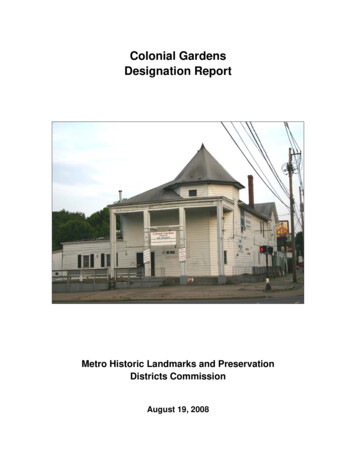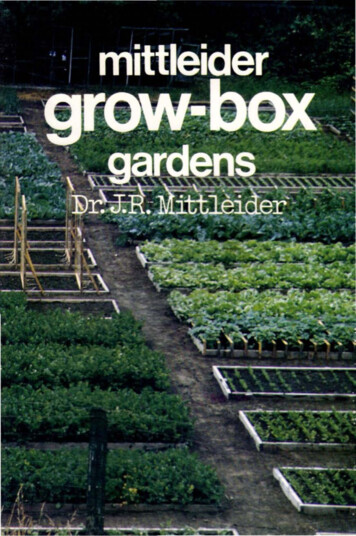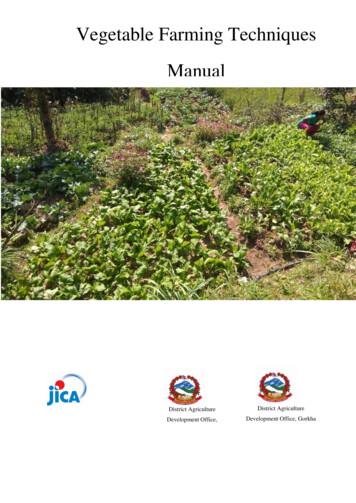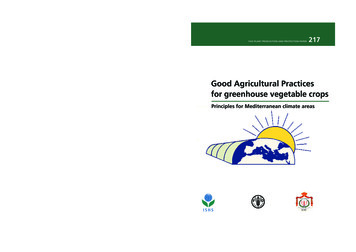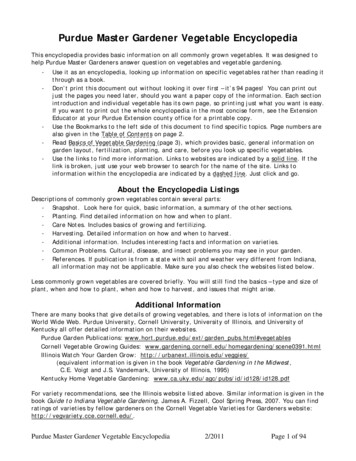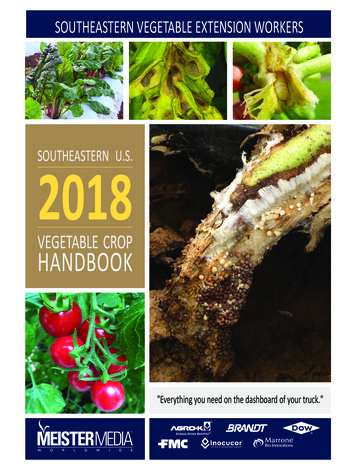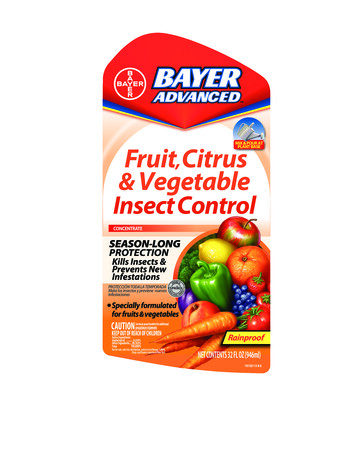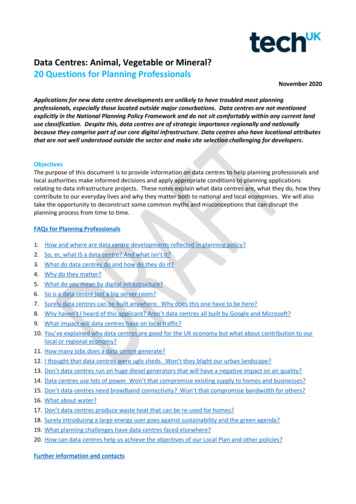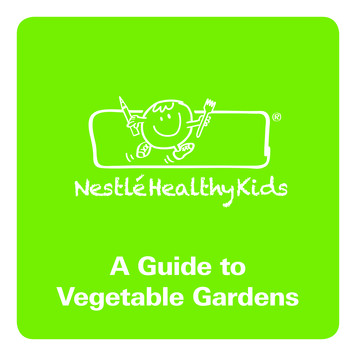
Transcription
A Guide toVegetable Gardens
The Nestlé Healthy KidsProgramme: Promotingnutrition education andphysical activityThe Nestlé Healthy Kids Global Programmeaims to increase nutrition and healthknowledge and to promote physical activityamong school-age children around the world.Nestlé Healthy Kids local programmes areimplemented in many countries around theworld. They are based on multi-stakeholderapproaches, working with partners suchas national and local governments, NGOs,nutrition health institutes and sport federations.This brochure has been produced by theNestlé Healthy Kids Global Programme fordistribution to teachers and parents. It is asimple and useful guide that explains howeveryone can grow their own vegetables,whether small-scale, for home or classroomobservation purposes, or large-scale,to help feed a local community.The original version of this booklet wasdeveloped by Nestlé Ecuador: the HealthyKids programme in Ecuador was the firstto promote gardening as a means forencouraging vegetable and fruit consumptionwhile developing environmental awareness.This programme offers workshops on organicgardening and how to implement them ineducational centres.
Contents41.1.11.2IntroductionWhy grow your own vegetables?The benefits of a vegetable garden6672.2.12.22.32.42.5Where can you plant a vegetable garden?Who can help?What you need to build a vegetable gardenTools and basic equipmentSeedsGood soil88101113143.3.13.23.3The importance of fertilizerOrganic fertilizerCompostHow to make compost161618194.4.14.24.34.4Step-by-step guide to making a vegetable gardenHow to make a vegetable gardenMaking a grow boxPreparing the soilFilling the grow boxes2222232425
5.5.15.25.35.45.5Planting your vegetable gardenSowing seeds directly into the groundSowing indirectly into seedbedsSeedbedsPlanting the seedsHow to transplant seedlings2626282930326.6.16.2Looking after your vegetable gardenHow to care for your gardenHow to improve soil3434367.7.17.27.3Using water wiselyWatering and saving waterSimple tricks for saving water in your gardenDangers of contaminated water383840418.8.1Dealing with pests and diseases naturallyPreventing diseases42429.9.1Harvest timeHow to plant, sow and harvest at the right time4444
1. Introduction1.1 Why grow your own vegetables?Nowadays, families strive to preparebalanced menus, based on nutritiousingredients. A vegetable garden is asimple and sustainable way to improveyour quality of life.Freshly-picked radishes or a tasty freshlettuce that is the product of your ownlabour: these are very real examplesof how we can improve the nutritionand physical well-being of families andchildren.6
1.2 The benefits of a vegetable gardenBetter quality, more nutritious food All the fruit and vegetables grown in yourgarden are easily grown by yourself. It doesnot require specific skills and is relativelyinexpensive.Environmentally-friendly Using organic waste matter as fertilizer,we can reduce landfill waste, therebyreducing pollution.A vegetable garden has otherbenefits too A shared space and activity that encouragesboth children and adults to spend timeoutdoors. A vegetable garden can increase children’svegetable consumption and willingness to trynew vegetables they have grown. A place to learn, an opportunity to workthe land and learn about our local environment.A garden can teach us to love Nature, createan interest in conservation and encourage usto respect life.
2. Where can you planta vegetable garden?2.1 Who can help?Large vegetable gardens are much moresuccessful when the community is involvedand motivated. Getting people involved rightfrom the start in planning and discussing thegarden is an excellent idea. This will buildcommitment, spread the workload, help youavoid mistakes and stimulate interest in theschool or the community’s activities.Parents and volunteers can help with gardenwork. Parents can help with children’sgardening tasks and homework. They canvisit the garden and participate in talks,demonstrations, food fairs and celebrations.In addition, local partners, companyvolunteers and local communities can beinvolved and provide their time, expertadvice/collaboration, help, supplies,equipment, etc.8
2. Where can you planta vegetable garden?2.2 What you need to build a vegetable gardenAll an organic vegetable garden needs is alittle soil: it doesn’t need to be big. In thisguide, we recommend using grow boxesor plant pots. You might start out with justfour lettuces in a plant pot, or some leafytomato plants in a large window box, but theexperience is always magical and satisfying.10Every plant, every living thing, opens a doorinto a world of discovery and learning. All wehave to do is watch and care about what weare doing.
2.3 Tools and basic equipmentTrowel Handy for moving seedlings to the beds.Also ideal for making drills for the plants.Cuts without damaging.Hoe Hoes are used for weeding and gardening.The steel blade sinks into the earth to removeweeds and stir the soil, thus giving keeper plantsmore moisture, nutrients, and growing space.Secateurs Secateurs should fit your handcomfortably. Use them to make clean,accurate the cuts.Those tools are best used by adults.Should children need to use them,ensure adult supervision at all times!
2. Where can you planta vegetable garden?2.3 Tools and basic equipmentHand fork Good for weeding around the plants andaerating the soil. Ideal for turning the soil.Watering can Use a watering can if you have one orsimply punch a few holes in a plastic bottle.Spray bottle Use for spraying plants, getting rid of dustand treating pests.12
2.4 SeedsThe best way to grow healthy plants isto keep your own seeds or buy themfrom certified organic shops. The seed is the part of the plant that wesow in our garden. Good seeds are clean,germinate quickly and are resistant to pestsor disease.
2. Where can you planta vegetable garden?2.5 Good soilThe soil is the starting point forevery food chain and the top priorityfor organic gardeners. Good soil isessential if you want plants that: Grow well Are resistant to disease and pests Are nutritious14
3. The importance of fertilizer3.1 Organic fertilizerPlants feed on substances found in thesoil, but over time the floor nutrientsin the soil are depleted, and we needto use fertilizer to replace them.Organic fertilizer is a natural product obtainedfrom the decomposition of plant and animalmatter. Organic fertilizer can make the soilmore fertile. There are a number of differentorganic fertilizers, including compost,vermicast (worm humus), and manure.16
3. The importance of fertilizer3.2 CompostCompost is made by allowingfood leftovers and garden wasteto decompose. It is also known ascompound fertilizer. Organic plant matter: weeds, plant waste(hay, pods, fruit, fallen leaves, old plants, etc.),sawdust, wood shavings. Domestic waste: biodegradable products(all kitchen waste other than plastic, tins, glassand other non-biodegradable products). Plant ash, lime, earth, water.Avoid fatty foods like meat and dairy products,and large chunks of wood, plastic, metal,glass, wire and other materials that are notbiodegradable.18
3.3 How to make compostWhat to doThere are different ways of making compost:on the ground, in a container, or in a pit dugin the ground.If you are using a container, it is best topierce a few small holes to allow water todrain. Whichever method you choose, youwill need to follow these instructions:1. Choose a shady spot that is easilyaccessible.2. Flatten and level the ground and aerateby turning the soil over. If you are using acontainer, puncture the sides to allow air tocirculate. It is also best to mount the containeron bricks to raise it above the ground and makeit easier to remove the compost when ready.
3. The importance of fertilizer3.3 How to make compostWhat to do203. Layer the waste matter for composting: Finally, 2 cm of soil or mature compost. The bottom layer (drainage layer) shouldbe about 2 cm deep and contain dry matterlike leaves, hay and dry stalks. A 20 cm layer of plant matter:kitchen and garden waste.You will need to water the compost heap asyou work: water speeds up the fermentationprocess. Keep on adding layers in this orderuntil your container is full. The compost heapshould be about one metre high. Don’t forgetto keep watering. A 5 cm layer of manure or other animalfertilizer. If you do not have any manure, youcan use lime or ash.4. When you have added the last layer, coverwith straw, dry grass or a damp cloth to keepthe heat and moisture in. Water one last time.
3.3 How to make compostDon’t forget Keep your compost heap moist. Turn the heap once a fortnight to make sureeverything decomposes at the same speed. It takes 90 days to several months tomake organic compost, depending onthe temperature and humidity.Organic compost should be darkbrown, with a soft, crumbly textureand pleasant earthy smell.
4. Step-by-step guide tomaking a vegetable garden4.1 How to make a vegetable gardenYou can create your own vegetable garden bysowing seeds in grow boxes made of wood,brick or breeze blocks. You can also sowyour seeds in any other unused clean andappropriate container.Make sure you put the containerssomewhere that gets sunlight during mostof the day and is close to a water source.22
4.2 Making a grow boxWhat you need Wood Nails Wooden batonsWhat to doMake your grow boxes using wood. The idealsize is 60 cm long by 45 cm wide and 15 cmhigh. Reinforce the corners with woodenbatons and make sure that you use plenty ofnails to attach the base – you don’t want it tobreak under the weight of the soil. Rememberthat the boxes should be easy to carry: don’tbe tempted to make them any bigger.Leave about half a centimetre between eachplank or make small drainage holes. Standthe boxes on small wooden batons or bricks.
4. Step-by-step guide tomaking a vegetable garden4.3 Preparing the soilTo prepare the soil you can mix: Garden soil Compost or decomposedorganic animal waste SandWhat to doMake sure that the soil does not contain anystones, glass, litter, etc. Break up any largelumps with your hands and mix until all threeingredients are evenly distributed. You willuse the mix to fill the grow boxes.24
4.4 Filling the grow boxesHow to fill the grow boxes andcontainer Place a 2.5 cm layer of gravel, pebbles orbroken clay tiles on the base for drainage. Add 5 cm of plant matter – garden orkitchen waste (fruit peel, pods, leaves). Add a 10 cm layer of the soil mix that youprepared earlier: one part garden soil, one partcompost and one part sand. Finally, cover with a 2 cm layer of vermicast(casting and manure produced by wormswhich act as fertilizer).Your grow box is ready for planting Use the same system to fill any plant pots,plastic tubs and other containers that youplan to use to grow vegetables, herbs andother plants.It is best to grow plants with fairly short rootsin grow boxes: lettuce, spinach, beetroot,chard, parsley, coriander, radishes, herbs,etc. Use deeper containers for plants withlonger roots.
5. Planting yourvegetable garden5.1 Sowing seeds directly into the groundThere are two ways of sowing seeds,depending on the size of the seed. The bestplanting method is always indicated on theseed packet.Sowing directly into the ground Sowing the seeds where they will grow.Usually this method is best for larger seedsthat are easy to handle.Sowing indirectly into seedbeds Best for plants with very small seedsthat are difficult to handle. The seeds aregerminated in a propagator and movedoutdoors later.26
Make sure that your grow boxes are moist. Use a trowel or your finger to make holes2-3 cm deep. Place the seeds in the drills. The distance between the drills will varyaccording to the size of the plants. Leave 1-2cm between small plants like radishes. Forlarger plants like lettuces, you will need toplant the seeds in drills 20-40 cm apart. Using your hands, gently cover the seedswith soil. Make sure that they are not buriedtoo deep and remove any lumps of soil.The following plants can be sownin the ground: radishes, potatoes,carrots, beetroot, beans, peas, garlic,spinach, cucumber, coriander, parsleyand basil.
5. Planting yourvegetable garden5.2 Sowing indirectly into seedbedsThis method uses a seedbed or propagator.The baby plants are protected from heavyrain, frost and strong sun. Once they areready to be transplanted, the plants can bemoved outdoors.Plants best started into seedbeds Lettuce, onion, cauliflower, broccoli,celery, chili peppers, tomatoes, oregano,strawberries, cucumber, gooseberries. You can use a sheet of plastic or glassand sheets of newspaper to protect babyplants from the cold at night, dependingon the temperature in your country.28
5.3 SeedbedsYou can grow seedlings in plastic pots,ice-cream tubs, egg boxes or any othercontainer. Why not try cutting a milk cartonin half? Fill the containers with the soil mixyou used in your grow boxes.Before planting any seeds, you need to sterilizethe soil. Scatter with plant ash to preventdisease; plant ash is the residue of burnedplant parts.You will need two heaping spoonfuls of ash foreach small container. You can also use boilingwater to sterilize the soil.
5. Planting yourvegetable garden5.4 Planting the seedsMake 2 cm drills in moist soil. Place the seeds5 cm apart, cover with soil and water carefully.Remember to mark each drill with the nameof the plant and the date using labelled stakesor lolly sticks. You can use a pencil, pen orfelt-tip pen.Strong, healthy seedlings need moistsoil that is free of weeds. Water inthe morning and the evening.30
5. Planting yourvegetable garden5.5 How to transplant seedlingsThe seedlings are ready to be planted outwhen they have four leaves or the stalk is asthick as a pencil. Transplanting means movingthe seedling and surrounding soil to the growbox or container.Here are some
4.2 Making a grow box. 4. Step-by-step guide to making a vegetable garden 4.3 Preparing the soil To prepare the soil you can mix: Garden soil Compost or decomposed organic animal waste Sand What to do Make sure that the soil does not contain any stones, glass, litter, etc. Break up any large lumps with your hands and mix until all three ingredients are evenly distributed. You will .
